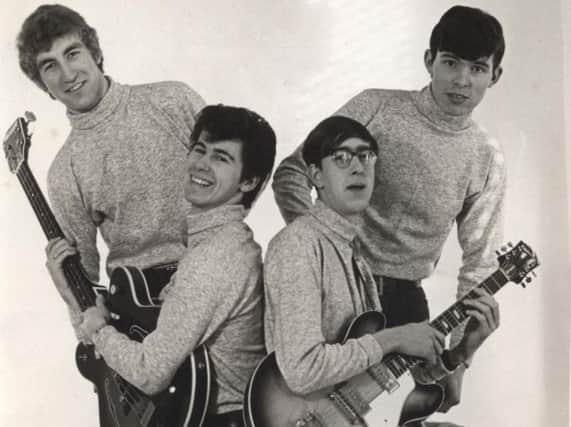Nostalgia: Harrogate band's road to fame in Swinging Sixties


Here, for the first time, as part pf our Retro nostalgia series, is the group's rarely heard story, as told by original band member Steve Carpenter.
Anyone who wasn’t around at the time may be excused for a degree of scepticism, but those of us who were teenagers in the 60s know, without doubt, that the 60s was the best of decades and that it will never be surpassed.
Advertisement
Hide AdAdvertisement
Hide AdA musical revolution was taking place. As teenagers, then, we wanted to be a part of it. Moreover, we came to believe that it was possible for any one of us to be the next big thing – it was just a matter of when!
We were just four local lads aged between 15 and 18 who had found one another through friends of friends.
None of us had had much experience of handling an instrument, but with hard work and enthusiasm we were very quickly performing as The Vikings.
The band comprised Bernard Bruyneels on drums, Ian Woolnough on rhythm guitar, myself on bass and John Lunn on lead guitar (later to be replaced by Stewart Gilbert, when John went off to art school). We all took a share of the singing.
Advertisement
Hide AdAdvertisement
Hide AdAlmost from the outset we had an impressive and most effective manager, Bernard’s father (Mr. E.L. Kennedy Bruyneels), a road manager, (my brother Mike Carpenter), and two fan club secretaries (Paula Bruyneels and Lynda Lupton), who published a monthly newsletter and arranged events for our followers.
Our equipment left a lot to be desired. Bernard started out with a second-hand bass drum bought from the Salvation Army; we all plugged into a single home-made amplifier, and, initially, I was playing an old double bass with an electronic pickup.
Almost from the outset we had a weekly ‘residency’ at a local youth club, St. Aelred’s on Stonefall Avenue. Then the bookings came in thick and fast.
One thing we did make time for was songwriting. It was almost obligatory for groups at that time if you wanted to be taken seriously.
Advertisement
Hide AdAdvertisement
Hide AdOne memorable night in 1965 we had a private recording session at a small studio just off the Headrow in Leeds.
We recorded four of our songs and in due course received copies of the recordings on 3 inch spools of tape.
One of the copies was duly despatched to George Martin who personally replied as follows: “Thank you for your letter of recent date enclosing a tape of The Vikings. I have given these tapes careful consideration but regret to say that I am unable to offer The Vikings any commercial recordings. Although they are a very competent group, these days are of such fierce competition a group has to have a very different sound to succeed on record. I am returning the tapes herewith and thank you for letting me hear them.”
Undeterred, the group continued, still believing we would soon be ‘going places’.
Advertisement
Hide AdAdvertisement
Hide AdThree months later we were in the final heats of the Melody Maker National Beat Contest at the Wimbledon Palais, having been shortlisted from hundreds of entrants nationwide.
Our manager arranged for coaches to convey nearly 100 of our fans to the venue and a wonderful time was had by all.
Sadly we only managed to come fifth out of the eight groups performing on the night. So that was that, as they say.
The following Saturday night marked a new chapter in our career, perhaps the one I recall with the greatest nostalgia.
Advertisement
Hide AdAdvertisement
Hide AdIt was to be the first of many nights when The Vikings would support chart-topping acts on stage at the Royal Hall.
On this occasion it was Manfred Mann featuring Paul Jones who, at the time were enjoying great success with Do Wah Diddy Diddy. It was 8 shillings and sixpence to get in and the double decker buses queued up outside the hall once the event was over to ensure you got home safely. The audiences for such events were almost entirely teenagers.
In the next couple of years we played at the Royal Hall alongside the Walker Brothers, the Fortunes, the Hollies, the Kinks, the Spencer Davis Group, the Small Faces, The Who and the Tremeloes. Wonderful times!
My clearest memory of the gig with the Walker Brothers was the moment at which the audience somehow managed to drag Scott Walker from the stage.
Advertisement
Hide AdAdvertisement
Hide AdThere was immediate concern but the stage security staff stepped in and somehow managed to drag him back.
Compared to the cool professionalism of the Walker Brothers, the Kinks were exciting, edgy and somehow raw, qualities.
The Who were a revelation: loud, enthusiastic and gritty. Their closing set left us all in shock: first the controlled feedback, something they had already developed into a fine art, but then the ‘abuse’ of guitars, drums and amplifiers, culminating in their complete destruction, the drum kit finally being propelled into the auditorium.
The audience left in silence.
Invariably, we got on extremely well with the headline groups.
Advertisement
Hide AdAdvertisement
Hide AdHad we been a little less cool, perhaps we would have collected their autographs and had our photo taken with them, something to show the grandchildren!
But we wanted to keep our composure, after all we knew that sometime in the near future we would be the visiting celebrity group.
It would just be a matter of time!
By Steve Carpenter